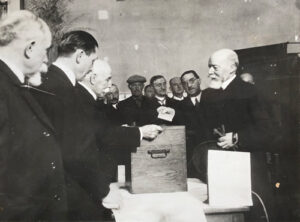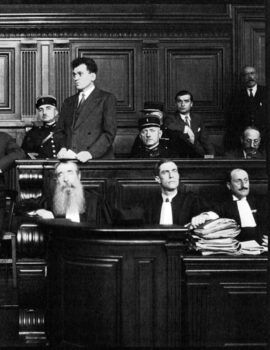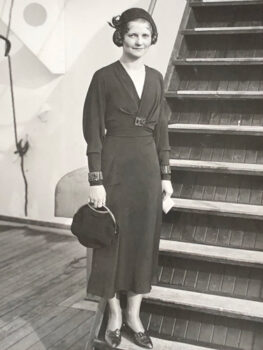Stranger Than Fiction
November 2023
Witness to an Execution: When French Officials Refused to Allow Women to See the Guillotine in Action, One American Journalist Refused to Back Down
by Dean Jobb

A slightly built figure zigzagged through the crowd of people assembled on Boulevard Arago, at the entrance to Paris’s La Santé Prison. Whoever it was looked more like a boy than a man, and too young to watch a beheading, but no one seemed to notice or care. All eyes were on the wooden frame of the guillotine that had been erected on the street just before dawn.
A cordon of soldiers and policemen encircled the execution site. When a few of the guards stepped away to break up a scuffle, the boyish figure rushed forward and joined an inner circle of government officials, lawyers, and journalists who had been issued passes and were authorized to witness the execution.
Within moments a black, horse-drawn wagon emerged from the prison gates. The soldiers raised their sabers, silencing the crowd. The condemned man, his hands bound behind his back and his legs shackled, was supported by guards as he shuffled toward the guillotine. “He had a peculiar, twisted smile on his face,” the interloper would recall, “half angel and half devil.” The prisoner was placed facedown on a raised bench and positioned to ensure his neck was directly under the blade. The back of his head had been freshly shaved, to make the executioner’s work easier.
The gas jets of nearby street lamps dimmed, leaving little to see but gloomy shadows and ghostly silhouettes. A bell chimed at the convent opposite the prison. Moments later, “the knife fell swiftly, surely,” recalled the gate-crasher, who was among the few close enough to see. For the thousands of others in attendance, a loud thud announced that the execution was over.
The determined spectator was an American journalist wearing a disguise. French officials had barred United Press reporter Mary Knight from covering the beheading because she was a woman. Outraged, she had devised a plan to get close enough to defy the edict and get the story. “I stood beside the guillotine,” she triumphantly announced in an account that made headlines around the world in September 1932, “the first woman to witness an execution in France from the enclosure reserved for officials and journalists.”
*

Knight came from a prominent Atlanta family and had long relished the challenge of proving herself the equal of any man. Her father, the journalist, historian, and archivist Lucian Lamar Knight, deserted the family when she was young and her role model was her fiercely independent mother, Edith. After the deaths of her mother and older sister Frances, she worked for publications in New York for a few months before heading to Europe in 1930 at age thirty-two with a dream of becoming a foreign correspondent. She craved travel and excitement. While most people were content to “live in grooves,” she once said, she “would rather dance on a volcano than sleep in a feather bed.”
At a time when many female journalists were still relegated to editing the women’s pages or to compiling society news, she talked her way into a twenty-five-dollars-a-week job at the Paris bureau of the United Press. She covered the city’s trendsetting fashion scene—she considered it “the world’s biggest racket”—and was more interested in business intrigues than clothes. Soon she was tackling major stories and interviewing newsmakers. She chatted with Marie Curie in her laboratory, sipped warm goat’s milk with Gandhi, and buttonholed European royalty. She became adept at slipping past guards and gatekeepers to snag exclusive interviews or to capture deathbed scenes. “She is one of the bravest people I have ever met,” noted an interpreter who accompanied her on one assignment. “She ought to have been a man!”
Reporting on an assassin’s final moments would be one of Knight’s greatest challenges. Paul Doumer, France’s bald, white-bearded, avuncular president, was attending a charity book fair in Paris in May 1932 when a bystander fired three shots from a Browning handgun. Two bullets hit Doumer, in the head and chest, and he died the next morning.
The gunman, thirty-seven-year-old Russian émigré Paul Gorguloff, claimed the murder was retaliation for France’s support of the Soviet regime. Rabidly anti-communist, he had fought against the Bolsheviks before fleeing to France and proudly declared himself “an admirer of Hitler and Mussolini.” His claim to have kidnapped the Lindbergh baby—the child was “being kept as a hostage to be brought up by Russian terrorists,” he said—was held out as proof he was insane. Knight was convinced he was “altogether and irrevocably mad.” French authorities, however, dismissed his ravings as a ploy to avoid the guillotine. A jury convicted him of murder and he was sentenced to die on September 14, 1932.
Knight applied for a press pass to attend. The request was denied on the eve of the execution. “No woman since the French Revolution officially has been permitted to witness a beheading,” was the government’s curt response. She was incensed. “I had covered murders, suicides, brawls and bawdy houses,” she noted later, yet “I could not stand three minutes and see a man’s head cut off because I was a woman!” She had until dawn to come up with a plan to witness Gorguloff’s death.
*

When French lawmakers were considering the abolition of capital punishment in 1789, Dr. Joseph-Ignace Guillotin, a professor of anatomy in Paris, weighed in. The nobility had the right to quick death by beheading—assuming the executioner was skilled and used a sharpened blade—while common criminals were hanged, burned alive, or tortured to death. Guillotin wanted to level the playing field. “Decapitation effected by a simple mechanism,” he suggested, would make executions more “egalitarian and humane.” The idea was accepted. Others designed and manufactured the machine, but Guillotin gave it a name.
The guillotine’s first victim was convicted robber Nicolas-Jacques Pelletier. The throngs that turned out for his 1792 execution, accustomed to watching the condemned suffer grueling deaths, went home disappointed. “The people were not satisfied at all,” one newspaper griped. “There was nothing to be seen. Everything happened too fast.” The machine’s speed and efficiency, however, were ideal for mass executions. As many as 40,000 men and women were guillotined during the French Revolution and the Terror that followed, including the deposed king Louis XVI. On an October day in 1793 the Paris guillotine dispatched twenty-one people in less than forty minutes.
The killing machine became a macabre pop icon. Women wore tiny guillotines as earrings. Children used miniature models to decapitate mice, birds, and toy soldiers. Public executions became must-sees for tourists visiting Paris. The French government phased out the ghoulish spectacles by moving the place of execution from public squares to prison entrances. While the guillotine’s grisly work continued to be carried out in public until 1939, spectators were kept at a distance and able to see little in the dim predawn light.
Knight claimed “scientific interest,” rather than “morbid curiosity,” was her reason for wanting to witness Gorguloff’s execution. She was also determined, she admitted, to “get even” with the French officials who discriminated against her. She borrowed clothes from a male friend, tucked her bobbed hair under a cap, slipped her feet into oversized shoes, and hid near the guillotine for hours. Once the deed was done, she returned to her flat “in a daze of unreality” and tried to make sense of what she had seen. “Was I glad—or sorry?” she asked herself. Another United Press correspondent, Reynolds Packard, had covered the execution, but when Knight told bureau chief Ralph Heinzen what she had done, he insisted she file a first-person account.
The wire service distributed at least three versions of her story, describing her bold undercover mission and Gorguloff’s swift death. “The spectacle was not too terrifying to me personally,” she assured readers, “but it was a ghastly scene.” She saw the blade fall and the assassin’s head tumble into a basket. “It was all over in a few seconds.” She held back some of the gory details. Later, in a memoir of her exploits as a journalist, Knight recalled how “a dark jet” had spurted from Gorguloff’s severed neck as the jugular vein emptied, prompting firemen to move in with a hose to wash away a pool of blood.
The stories created a sensation. Many American papers ran her exclusive on page one. Some ignored Packard’s dispatch or gave Knight top billing. “Woman Sees Hated Assassin of Paul Doumer Guillotined,” was the all-caps banner headline in Connecticut’s Waterbury Democrat. The Atlanta Constitution celebrated the journalistic coup of the “former Atlanta girl.” Knight likely bristled when she discovered that many headline writers described her as a “Girl Reporter” or “Girl Writer.”
The story went viral. She was sent back to the United States and toured the country, meeting publishers and editors, stopping for interviews, and promoting United Press. Journalism schools and clubs invited her to speak. Her clandestine adventure was dramatized for radio.
The escapade kick-started Knight’s career. She became a correspondent based in Asia, filing stories for newspapers across America. Then she transformed herself into “a modern Nellie Bly,” as the New York Times put it, taking on undercover assignments reminiscent of the famous nineteenth-century journalist. She posed as an extra in Hollywood movies, worked as one of the first “air hostesses” on a transcontinental airline, went undercover as a nurse—and always emerged with the inside story. By 1938 she had amassed enough accomplishments and adventures to publish a memoir with the apt title, On My Own.
It was ironic, Knight noted in the book, how “one reckless . . . act of inexcusable ire” could become “the pivot around which a whole career swings.” None of the stories she covered after the Gorguloff execution, none of the scoops she scored working undercover, “created so much comment as that one moment of unintentional flagpole sitting.”
When she left the Paris bureau of the United Press in 1935 to report from China, one of her bosses paid her what was perhaps the ultimate compliment a female journalist could earn in the male-dominated profession. “You’re a tough guy, Mary,” he told her, “and a first class newspaperman.”
Copyright © 2023 Dean Jobb
